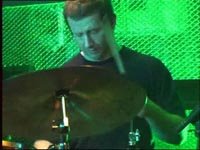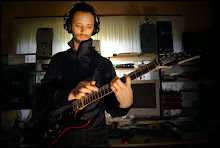Elder Conservatorium Music Tech Weekly 01/06/06
Audio Arts:Drum kit micing:
Under kill may be an appropriate way to describe the set up created by us this week. Kick, snare, room ambience and overheads were the only mics used while our resident percussionist Patrick McCartney did his thing on the skins (damn that boy got rhythm!). I completed my recording of Tuscadero for Audio Arts on Monday night and had a total of nine mics on the drum kit. This was hardly a comparable situation though, as I had a five piece band in the space at the same time. I felt the results from Tuesday could potentially be suitable regardless of mic placement depending on the desired end result. If recording isolated drums like this, I would also be inclined to use less mics. As Hugh Robjohns suggests, close micing is only necessary where bleed is an issue.
On close inspection of the session I think it was highly beneficial to mic the snare and kick along with overheads. Soloing the overhead mics exposes a spacious but thin sound overall in my opinion (that is what this is reflecting after all). The different room positions with the Neumann offer similarities in response from the sides of the kit and between front and back. The rear is the strongest position I felt, capturing most of the kit evenly.
Creative Computing:
Basic Tape Techniques:
This week’s lecture focused on exploring the roots of sound manipulation possibilities. It’s interesting to consciously apply an approach which I would always use by default. Since my early efforts at sound recording I have understood the need to capture a good sound on tape before applying alteration effects. The theory behind this mindset can be adhered to, even when performing basic sound editing. For instance, an interesting and desirable new sound can often be created by constructing a ‘palindrome’ of an original sample by use of simple reverse and splicing tools. The ‘raw’ sound is not necessarily altered in the way it would be via use of a ‘plug in’ effect. The end result here is basically another sample available for use which is pretty much still in raw data form.
The point I, and this weeks lecture are trying to make, is that while the effect plug ins in programs like Pro-tools have their uses, they should only be used as a last resort. If you can achieve a satisfactory result without them, the quality of sound is usually more ‘solid’ and will often sound desirably organic by comparison. I’m only speaking from my own experience of course, but check out what I’ve done with Jodie Vs NIN and decide for yourself if my approach is worthwhile……
Jodie Vs NIN
Listening Workshop:
Nobukazu Takemura – ‘Assembler’:

I coined a new word for this one ‘Xylophonic’. Digital pops seem to be making an inroad to becoming an accepted sonic tool nowdays. It contains a heavy mash of organ sounds and made impressive use of the wide frequency range offered by the instrumentation. The ending was a little abrupt….
Gut Bucket – ‘Snarling wrath of the angry gods’:

Aggressive, dare I say it: ‘grunge’ influenced prog rock. Lots of time changes and a virtuosic (if a little out there) saxophone solo. Held together very tightly for a complex arrangement…
J S Bach – ‘Six part Ricecaro’:
What can I say - I love Bach but have always been adverse to the nasally timbre of the harpsichord. Nothing has changed there. This piece seems to be pre occupied with exploring endless harmonic possibilities in every key, all the while slapping the listener with cadence after cadence and never committing to an ending. Or maybe I’m just an uneducated ignoramus - I am sitting here bagging Bach while listening to Daft Punk….
Toby Twining – ‘Kyrie’:
An accapella piece with bizarrely chosen harmonies for the human voice. Toby has done a great job of combining the deep resonance of harmonic throat singing with traditional choral styles. The wide contrast between the rhythms in individual voices is particularly effective.
Arnold Dreyblett – ‘Lapse’:
More prog influence here, with odd percussive choices and instrumentation. Dischordant harmonies are also a feature. I like the straight rock timing vs the swing thing. Very Clever.
Otomo Yosihide with John Zorm – ‘Hardcore Chinese Opera’:
The glorious sound of human torture. Very disturbing indeed.
Stravinsky – ‘Symphonies of Wind Instruments’
Although this piece is written using a block technique, it all seem to be at least rhythmically relevant. It reminded me of a film chopping between many different characters. I also found it strangely reminiscent of Saint Saeens’ Carnivale Des Animaux……am I weird?
Forum:
Vinny Bhagat:
Vinny performed a piece he’s had in the works for a few years now. It’s nice to hear some impressive D & B influenced music in between the cracks in the concrete…..
Audio example
Reference:
Robjohns, Hugh. “Recording Drums’. Sound on Sound. February issue. 2003. Pg 8 of 12.
Vinny Bhagat. "Artist Talk – Vinny Bhagat – Composing with reason." Performance presented at the Electronic Music Unit, EMU space, University of Adelaide, 01/06/2006.
Christian Haines. "Audio Arts – Drum Kit Miking". Practical Class presented at the Electronic Music Unit, EMU space, 5th floor, Schulz Building, University of Adelaide, 01/06/2006.
Christian Haines. "Creative Computing – Tape Techniques". Practical Class presented at the Audio Lab, 4th floor, Schulz Building, University of Adelaide, 01/06/2006.


4 Comments:
yeah underkill you got that right!
"
if something rattles on the drum kit, it will most likely come through in the recording
"
G R O U N D B R E A K I N G
Too true, I'm dreading what I might turn up when I listen to my recording closely......
"slapping the listener with cadence after cadence and never committing to an ending". WELL SAID. I also like the exploration of harmonic modulation and whatnot, but the harpsichord is a difficult instrument to enjoy in that context. Maybe I'm an ignoramus too. Then again, Bach might have liked Daft Punk, if he was still alive?
Piss off Bach you over rated dinosaur. By the way, you're dead. Ha!
Post a Comment
<< Home